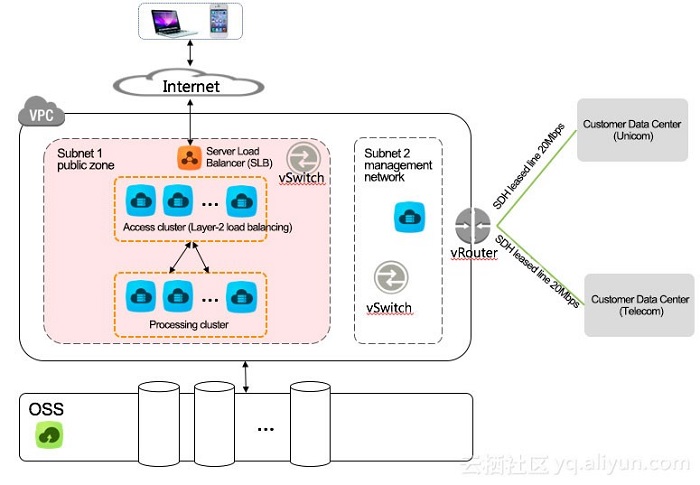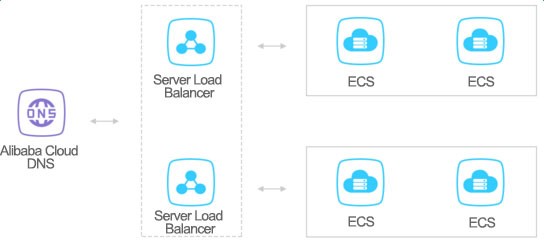The increasing development and popularity of cloud computing technology has brought with it far-reaching influences on traditional IT system building in terms of network construction, application operation, and system operation and maintenance. More and more companies are choosing to migrate their applications to the cloud to leverage on-demand access to computing power and build low-cost, flexible, high-performance, high-reliability-, highly secure IT business systems.
This article mainly covers how to migrate offline systems to the Alibaba Cloud computing platform, taking into consideration the composition of typical enterprise system architectures like the network, application service, file storage, and database service layers, to help you more smoothly and successfully migrate existing IT systems to the cloud and deploy new systems.
The network types of Alibaba Cloud products are divided into virtual private networks and classic networks.
In a classic network, each independent product has public IP and private IP addresses to facilitate convenient access by on-cloud and off-cloud customers.
An Alibaba Virtual Private Cloud (VPC) is a virtual private network built and customized on the foundation of the Alibaba Cloud platform. It features full logical isolation between different VPCs. You can create and manage cloud product instances, and configure route tables and gateways in your own VPC. In addition, you can establish a customized network environment by connecting the VPC to traditional data center through a private line/VPN to achieve smooth migration of applications to the cloud.
For example: migration from the traditional VLAN architecture to Alibaba Cloud VPC

The figure shows the architecture of an e-commerce website migrated to the Alibaba Cloud. This application is deployed in Shenzhen and Shanghai and with identical architecture in both locations. See details of the situation below:
• One VPC is created and deployed in each region.
• The VPC is connected to the Telecom and Unicom data centers belonging to the offline systems through the two SDH special lines.
• There are two subnets in the VPC, one public network zone and one administration network.
• The ECS in the VPC must be of the SSD type.
• SLB is used as the Layer-1 load balancer for providing external access services and the Tengine established on the ECS can be used as the Layer-2 load balancer.
For the application service layer, you can use SLB + multiple ECS instances to replace the traditional F5 + back-end server cluster, to migrate the application service layer onto the cloud.
Server Load Balancer (SLB) is a service that distributes traffic among multiple ECS instances. SLB can enable the application system to better serve customers by distributing and balancing traffic between multiple servers, as well as improve availability for the system by eliminating the possibility of a single point of failure.
An ECS (Elastic Compute Service) instance is a virtual computing environment that includes a CPU, memory, and other basic computing components. It is responsible for presenting the operating system to the user at zero upfront cost to the developer. With ECS you can create instances, resize disks, and release an instance any time you need to.
Traditional business systems deployed on x86 physical servers or virtual machines can be migrated to Alibaba Cloud by migrating the application image. Alibaba Cloud currently provides P2V and V2V tools that can be used to generate image files for most versions of Windows and Linux. You can import image files directly to the Alibaba Cloud image management center through the image import function in the Alibaba Cloud ECS console. The image can then be used to create ECS instances without having to reinstall the operating system, re-build the application infrastructure, or re-deploy your applications.
Application services running on the AIX, HPUNIX, and Solaris operating systems on small machines can be migrated to Alibaba Cloud ECS instances by means of app repackaging and manual deployment. The app repackaging and manual deployment approach mainly involves installing and configuring the basic environment, deploying application middleware, and developing and configuring code for the application. Once the manual deployment is complete, if it is a clustered application, you can create user-defined images through Alibaba Cloud to be automatically deployed to your ECS instances.
By configuring the SLB, the network traffic of HTTP/HTTPS, TCP and UDP can be distributed to different ECS instances on the back end according to polling, the minimum number of connections, or the weighting policy.
For example: The key to deployment is to meet disaster recovery demands on the application service layer and provide low-latency service to users from different regions.

Cross-regional disaster recovery can be achieved for applications with users in different regions where different carriers are used by using the enterprise version of Cloud resolution DNS to direct each user tot he SLB in the most appropriate region. A combination of SLB and ECS enables local disaster recovery for multiple zones, while the SLB health checks eliminate the possibility of single points of failure.
For file storage migration, you can directly use OSS to replace the traditional file server or NAS storage to store massive data files. Object Storage Service (OSS) is a cloud storage service provided by Alibaba Cloud that features massive storage capacity, high security, low costs, and high reliability.
OSS is mainly appropriate for the following scenarios:
• Massive storage for image and audio/video applications
• Static/dynamic resource separation for webpages and apps
• Use the Media Transcoding Service (MTS) and Image Processing Service (IMG) in combination to process data on the cloud.
Migrating a small number of small files to Alibaba Cloud OSS can be done through the OSS Web console, while a small number of small or large files can be uploaded via the OSS client. The OSS client features GUI-based drag and drop operations, automatic multi-part resumable uploads, and multi-thread uploads among a variety of other features. For large numbers of files, Alibaba Cloud recommends the OSSImport2 tool. OSSImport2 allows you to quickly migrate file data onto the cloud without storing it on the disk. Multi-thread and cluster deployment can also be implemented based on available bandwidth.
For example: file storage migration to OSS-a seamless migration solution

First the client accesses the OSS directly, then if the request is a read request and the file exists, the client returns the read result and the operation is over. If the file does not exist, then a redirection address is returned according to the back-to-source redirection rule, after which the client accesses the file in the source site and returns the result. For write requests, the client writes that data to the OSS and returns the result. At the same time, you can configure OSSImport2 on the back end to migrate the source site files to the OSS. After the migration is complete, you can cancel the back-to-source rule to achieve seamless, smooth migration to the OSS.
Big data is the driving force behind the transition from the IT era to the DT era. The source "data" comes from the thousands of applications that we come into contact with every day, like websites, forums, ERP systems, order systems, procurement systems, and games. Most systems process online transactions, and use relational databases like MySQL, MSSQL, and Oracle for data management.
The relational database service (Relational Database Service, or RDS for short) provided by Alibaba Cloud is a stable, reliable, and auto-scaling online database service. RDS uses an out-of-the-box approach that is compatible with MySQL, SQL Server, PostgreSQL and PPAS relational databases. In addition, it provides online database resizing, backup and rollback, performance monitoring, and analysis functionality. Using RDS with ECS doubles I/O performance and allows communication via intranet to avoid network bottlenecks.
Off-cloud MySQL, SQL Server, PostgreSQL, and PPAS can all find their counterparts on the RDS on Alibaba Cloud. You can establish Oracle databases on the ECS on the cloud or migrate the database to the cloud after making some minor alterations.
Alibaba Cloud mainly uses DTS for migrating database structural data. Alibaba Cloud DTS (Data Transmission Service) supports database-centered structures and data transmission between different storage products. It integrates capabilities such as data migration, data subscription, and real-time data synchronization. You can use DTS to easily create secure, scalable and highly available data architecture.
What's supported by DTS data migration
| Source database | Structure migration | Full migration | Incremental migration |
|---|---|---|---|
| Oracle -> RDS For MySQL | Supported | Supported | Not supported |
| Oracle -> RDS For PPAS | Supported | Supported | Not supported |
| MySQL -> RDS For MySQL | Supported | Supported | Not supported |
| SQLServer -> RDS For SQLServer | Supported | Supported | Not supported |
| PostgreSQL -> RDS For PostgreSQL | Supported | Supported | Not supported |
Partitioned Index - Alibaba Cloud RDS PostgreSQL Best Practices

2,598 posts | 770 followers
FollowAlibaba Container Service - February 11, 2025
Alibaba Container Service - February 19, 2025
Alibaba Clouder - August 6, 2020
Alibaba Container Service - November 7, 2024
Alibaba Clouder - March 31, 2021
Alibaba Container Service - December 26, 2024

2,598 posts | 770 followers
Follow Cloud Migration Solution
Cloud Migration Solution
Secure and easy solutions for moving you workloads to the cloud
Learn More Database Migration Solution
Database Migration Solution
Migrating to fully managed cloud databases brings a host of benefits including scalability, reliability, and cost efficiency.
Learn More Oracle Database Migration Solution
Oracle Database Migration Solution
Migrate your legacy Oracle databases to Alibaba Cloud to save on long-term costs and take advantage of improved scalability, reliability, robust security, high performance, and cloud-native features.
Learn More ADAM(Advanced Database & Application Migration)
ADAM(Advanced Database & Application Migration)
An easy transformation for heterogeneous database.
Learn MoreMore Posts by Alibaba Clouder
Start building with 50+ products and up to 12 months usage for Elastic Compute Service
Get Started for Free Get Started for Free
Raja_KT March 9, 2019 at 3:48 am
Interesting. Hope you can mention the location from where to get P2V, V2V